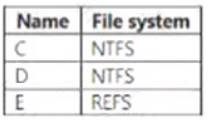- (Topic 3)
Note: This question is part of a series of questions that present the same scenario. Each question in the series contains a unique solution that might meet the stated goals. Some question sets might have more than one correct solution, while others might not have a correct solution.
After you answer a question in this section, you will NOT be able to return to it. As a result, these questions will not appear in the review screen.
Your network contains an Active Directory Domain Services (AD DS) forest. The forest contains three Active Directory sites named Site1, Site2, and Site3. Each site contains two domain controllers. The sites are connected by using DEFAULTIPSITELINK.
You open a new branch office that contains only client computers.
You need to ensure that the client computers in the new office are primarily authenticated by the domain controllers in Site1.
Solution: You create an organization unit (OU) that contains the client computers in the branch office. You configure the Try Next Closest Site Group Policy Object (GPO) setting in a GPO that is linked to the new OU.
Does this meet the goal?
Correct Answer:
B
DRAG DROP - (Topic 3)
Your network contains an Active Directory domain named contoso.com. The domain contains group managed service accounts (gMSAs). You have a server named Server1 that runs Windows Server and is in a workgroup. Server! hosts Windows containers.
You need to ensure that the Windows containers can authenticate to contoso.com. Which three actions should you perform in sequence? To answer, move the appropriate
actions from the list of actions to the answer area and arrange them in the correct order.
Solution:
Does this meet the goal?
Correct Answer:
A
HOTSPOT - (Topic 3)
Your on-premises network contains an Active Directory domain named contoso.com and 500 servers that run Windows Server. All the servers are Azure Arc-enabled and joined to contoso.com.
You need to implement PowerShell Desired State Configuration (DSC) on all the servers. The solution must minimize administrative effort.
Where should you store the DSC scripts, and what should you use to apply DSC to the servers? To answer, select the appropriate options in the answer area.
NOTE: Each correct selection is worth one point.
Solution:
Does this meet the goal?
Correct Answer:
A
- (Topic 3)
Note: This question is part of a series of questions that present the same scenario. Each question in the series contains a unique solution that might meet the stated goals. Some question sets might have more than one correct solution, while others might not have a correct solution.
After you answer a question in this section, you will NOT be able to return to it. As a result, these questions will not appear in the review screen.
You are planning the deployment of DNS to a new network.
You have three internal DNS servers as shown in the following table.
The contoso.local zone contains zone delegations for east.contoso.local and west.contoso.local. All the DNS servers use root hints.
You need to ensure that all the DNS servers can resolve the names of all the internal namespaces and internet hosts.
Solution: You configure Server2 and Server3 to forward DNS requests to 10.0.1.10. Does this meet the goal?
Correct Answer:
B
- (Topic 3)
You have an on-premises Active Directory Domain Services (AD DS) domain that syncs with an Azure Active Directory (Azure AD) tenant. You plan deploy 100 new Azure virtual machines that will run Windows Server. You need to ensure that each new virtual machine is joined to the AD DS domain. What should you use?
Correct Answer:
C
Reference:
https://www.ludovicmedard.com/create-an-arm-template-of-a-virtual-machine-automatically-joined-to-a-domain/